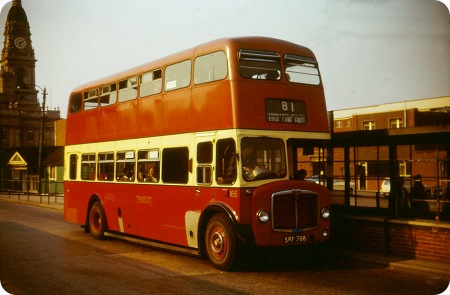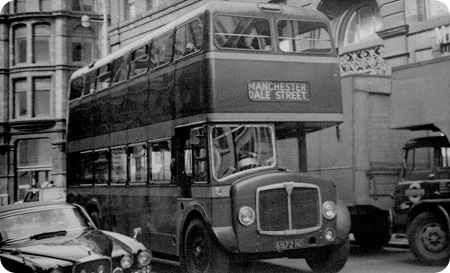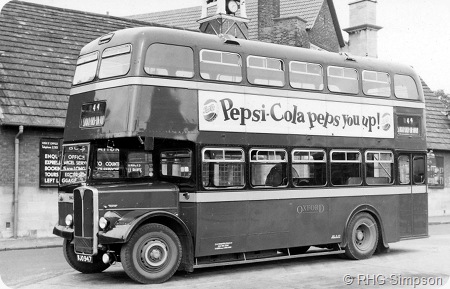Bolton Corporation – AEC Regent V – SBN 766 – 166
Bolton Corporation
1961
AEC Regent V 2D3RA
Metro Cammell H40/32F
Taken in Bolton bus station this Regent V is working route 81 Four Lane Ends I’ll come back to the destination later. This was one of a batch of six Regent Vs they were the first and only AECs that Bolton took delivery of since the solitary AEC Q of 1933. Their post war double decker fleet apart from the odd batch of Daimlers CVGs and quite a few Crossley DD42/3s have been Leyland Titans and Atlanteans. All Bolton vehicles passed over to SELNEC on the 1st of November 1969. One of the Regent Vs registration SBN 767 fleet number 167 as been preserved and there is a very good shot of it here and guess what the route number and destination is.
Linking this post with the Bradford post and Chris Youhill’s most recent comments.
Nothing beats a Roe decker for me but, as I have said previously, I fully agree with Chris that the Orion is much maligned. Apart from the first "lightweight" models, the Sheffield examples were always well turned out and finished. I too, have a soft spot for them.
These Bolton examples look to be in the same mould, but are strangely out of place in this fleet. I never remember them in my time in Greater Manchester from 1971 to 1980.
David Oldfield
Sister vehicle SBN 767 is currently in the care of the Bolton Bus Preservation Group but is off the road awaiting restoration. BBPG’s active fleet includes former Bolton Transport East Lancs bodied Atlanteans 185 and 232 and similar (but longer and delivered in SELNEC orange) 6809.
Neville Mercer
11/05/11 – 07:13
Yes the sister vehicle is still barely in existence however it is in a very poor state after being abandoned on a farm for a number of years. I’m led to believe that the farm owner is due to cut up and scrap the remains due to the fact that the owner/s haven’t paid any rent for the vehicle.
A. N. On
12/05/11 – 07:10
I believe the route the bus is working on is a short-working of the old SLT trolleybus route from Bolton to Leigh from Howell Croft bus station. I think the full route to this day is still numbered 582.
Dave Towers
14/09/12 – 06:52
Just to get things correct the location is Howell Croft South. Howell Croft was split in two when the Town Hall, seen in the background, was doubled in size. The 81 was in-fact a short-working on the 82.
Malcolm Gibson
03/11/14 – 06:31
A short lived colour scheme … seemed odd at the time … but when a few of the older Leylands were painted in this scheme … definitely odd!!
Iain H
03/11/14 – 16:27
The colour scheme was Ralph Bennett’s first as Manager, based on the Plymouth scheme from whence he came.
Phil Blinkhorn
04/11/14 – 06:44
This colour scheme on this chassis/body combination gives them quite a Hebble look.
John Stringer
05/11/14 – 06:32
It always puzzled me why Bolton bought these, as they were completely non-standard. The pre-Atlantean fleet was quite a mixed one really, as though they couldn’t make their minds up quite what they wanted – although basically Daimlers and Leylands with MCW or East Lancs bodies, hardly any two batches were the same – 30′ Daimlers with rear entrance MCW or front entrance East Lancs, PD2s with full-front MCWs, PD3s with rear or front entrance East Lancs, or full fronts, etc.
Michael Keeley
05/11/14 – 11:33
I think that often when an operator – particularly a municipal one – purchased an odd batch of vehicles that seemed ‘non-standard’ to mystified enthusiasts it was usually to do with the tendering process resulting in an offer they couldn’t refuse (in the interest of saving ratepayers’ money) or the manufacturer being able to offer more attractive delivery dates than the preferred supplier.
John Stringer
05/11/14 – 15:37
John makes an excellent point. Many a manager who, for excellent engineering or operational reasons, wanted a particular vehicle type, found himself over ruled by his committee for political or "economic" reasons. One of the most crass decisions was that of the Manchester Committee which denied Albert Neal his desired Tiger Cubs and forced the Seddon bodied Albion Aberdonians on him, breaking their own Leyland/Daimler only purchase rules and then, as Leyland owned Albion, having them listed as Leylands and having the Albion badges which Seddon had affixed, removed.
Of course the vehicles had a long, distinguished career – long in being kept as often as possible in the depot, distinguished in being of poor finish, ride and serviceability.
Phil Blinkhorn
06/11/14 – 06:10
Manufacturers sometimes did bid low in an attempt to penetrate a "glass wall" of long standing custom and practice in purchasing followed by some municipalities. Municipal General Managers did succeed in getting their own way much of the time, as could be seen from the often dramatic change in favoured manufacturer following the appointment of a new GM, but Transport Committees were the ultimate power, and a low quotation would have been mightily tempting to the custodians of ratepayers’ money. (One can imagine the heated reaction in camera from a GM who had suffered the imposition of an unwanted vehicle type in the fleet.)
Roger Cox
20/07/15 – 05:38
Yes, I always thought the same as Michael about Boltons fleet. They seemed to have a lot of small batches which were all different, some 27 feet long, some 30, some with tin fronts, some St Helens moulded fronts, and some exposed radiators and also the same with Daimlers. When they changed to Atlanteans they seemed to become more standardised, some of the earlier ones had Metro Cammell bodies, then they seemed to standardise on East Lancs.
David Pomfret
Quick links to the - Comments Page - Contact Page - Home Page



